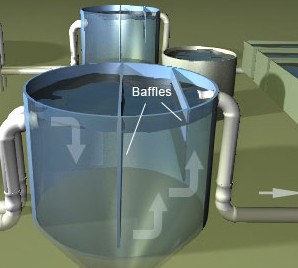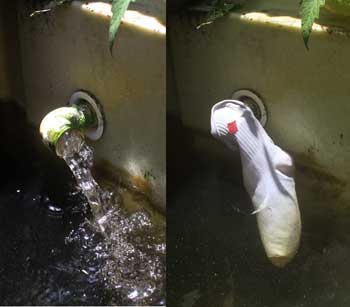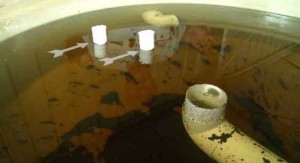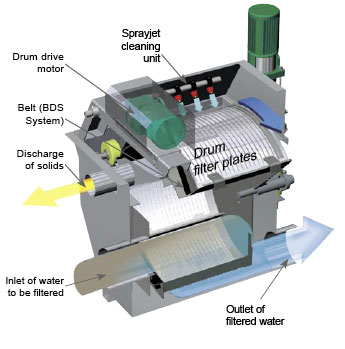Aquaponics and Filtration
Filters seem to be the bane of many people’s lives as they seek out many creative ways to remove fish effluent and waste from the water returning back to the fish tank.
Every day on Aquaponic forums people become obsessed with removing waste and seek out many ways to build extra plumbing into their system – large drum clarifiers, swirl filters, particulate filters, settling tanks to trap solids and prevent them from coming back.
Dirty water – be gone!
Solids are removed to make the water sparkling clean and habitable for the fish. The plants are fine. Remember they like the dirt. But the fish – the poor old fish look glum swimming around in effluent. Some fish can cope with living in a sewer – but eventually all fish succumb to disease and a nasty thing called Death.
So fish require some degree of filtration to be happy and prevent various diseases from breaking out.
So to what degree of filtration do you need in your aquaponics system? When should you start to worry?
In normal media based systems. Systems with hydroton or gravel in the growbeds growing vegetables, these become your primary bio-filtration mechanism. With a good assortment of composting worms and plants sucking up the nutrients, the grow bed media filter out the waste as the water passes through the media. This becomes your primary method of filtration and does a pretty good job of solids elimination.
A lot of fish matter waste can be seem deposited where the water trickles onto the grow-bed. It look s like a carpet of thick brown sludge – fish poo! The more fish you put into your tank – the more fish poo comes out the other end.
Its not rocket science.
For most people that lightly stock their tanks with fish – filtration will never become an issue. Water quality always becomes an issue when people look into their tank and think they can add another twenty or thirty more fish because the tank looks empty with the way the fish are all huddled together in a group.
Stock to your level of Filtration
Then as the weeks progress, they begin to notice the water quality becoming less clear. Lots of tiny particles are swirling around the tank, especially when the fish are startled and shoot around the tank raising a cloud. Fine particle matter is stirred up and the water looks like a hazy dusty cloud of fecal matter. The rule of thumb with keeping fish and filtration is to stock fish to your level of filtration. If you only have a very small grow bed and that is your primary filter mechanism – then you need to reduce your fish load or increase your filtration system. Add extra grow-beds to accommodate the increased fish load.
A build up of Organic Matter spells disaster
A build up of fish waste in your tank along with uneaten fish food, algae and organic matter if allowed to accumulate will affect the dissolved oxygen (DO) in your tank. As organic matter decays it produces carbon dioxide and ammonia. If you allow a lot of sludge to settle in your tanks, the dead matter will decompose anaerobically (without oxygen) and produce methane and hydrogen sulfide, which is very toxic to fish. You’re on a downward spiral if you allow your system to get out of hand. So some form of maintenance and water quality control needs to be implemented if you stock your aquaponics system with too many fish. Many seasoned aquaponics people advocate a lighter load in your fish stocking density for that very reason. Sometimes less is more. Try to keep the natural balance of your system in harmony.
Another reason why solids are removed in the commercial Floating Raft method of Aquaponics is to prevent sludge adhering to the roots of the plants which can result in poor plant growth. Plants grow better in heavily oxygenated water but the roots of the plants should not be coated with a heavy lining of sludge.
UVI Clarifier
The University of the Virgin Islands (UVI) developed a system of conical tanks or clarifiers to trap solids in their tanks through a couple of added baffles. The water column along with the solids would enter the tank and would “drop out” or fall to the base of a conical bottom to be trapped and later pumped out. A series of baffle obstacles would make suspended particles easier to trap as the water flowed down, up and out through the tank.
The particles would eventually coat the pipes and fittings of the tanks with a thick sludge which meant periodic and laborious cleaning.
Someone at the University had a bright idea and would occasionally throw a few tilapia fish into the clarifier tank to keep the pipes from blocking! In a commercial aquaponics system, Tilapia produce a lot of fish waste that needs to be eliminated from the system.
As good as clarifiers are – accounting for 59% of solids removal – they still cannot remove all the solid matter. A further series of tanks stuffed with netting are used to trap solids before the water flows on its way to the raft system growing the vegetables.
Swirl Filter
Despite how they are named – try not to think of the swirl filter like a agitated washing machine spinning water around rapidly. Quite the reverse. Swirl filters, rotate the water very very gently in a sweeping arc. Remember the water needs to move very slowly with the outlet pipe located in the center of the tank, just at the surface to gently capture water and send it on its way. The solids have plenty of time to sink as they gently “swirl” in a grand almost motionless spiral arc that traps matter and gently allows it to fall to the bottom of the tank.
In the image to the left, two polystyrene floats are shown moving in an arc at the edge of the tank to better illustrate the principle. Below in the water you can see the spiral arms of the settled solids. The principles of swirl filters and particulate filters is illustrated well in the Aquaponics Secrets DVD.
How much solids should you remove in Aquaponics?
Removing all the solids in an Aquaponics system is a difficult business unless you employ a large expensive commercially provided centrifugal drum filter that is designed to spin water and eliminate particles as fine as the width of a human hair. Your talking microns here and even then some fine particles wont be eliminated. You can set up any number of solids capturing tanks and settling devices and never fully eliminate the problem because a lot of the suspended particles are trapped in the water column – never to settle!
HOW DRUM FILTERS WORK
- The rotating drum is mounted on a frame with outer micron filter panels. The filter panel can be either polyester or stainless steel cloth that is of a specific micron porosity.
- Fish waste water with solid matter particles enter the Drum Filter from the inside the spinning drum.
- Solid waste particles are captured on the filter screens.
- Water escapes through the filter screen.
- A float level switch or timer initiates filter screen rinse that washes away solid matter to another tank where it is collected and disposed of. [/sws_blue_box]
But don’t get trapped in throwing out the baby with the bath water or obsessing over solids removal.
As solids undergo decomposition by microorganisms, nutrients essential to plant growth are released to the water, a necessary process known as mineralization.
Mineralization is the very essence of plant growth and if you removed all the solids you would then have essentially an aquaculture system devoid of nutrients – not an aquaponics system. You would need to supplement your plants with external nutrients because without sufficient solids for mineralization, more nutrient supplementation is required. This would then add to your operating expenses and increase management complexity in running such a system.
Aquaponics is an eco-system that many people don’t fully comprehend or understand.
A balance between keeping the fish healthy and the plants thriving is essential. Clean water is essential and so are the nutrients trapped within it.











Thanks a lot for the informations.
Best wishes for New Year.